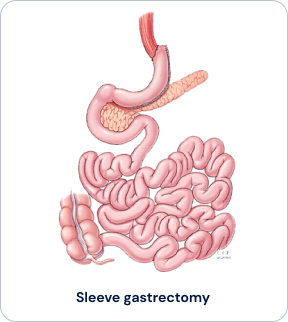- Anesthesia:
The patient is given general anesthesia, which puts them to sleep and ensures they do not feel any
pain during the
surgery. - Placement of instruments:
The surgeon makes several small incisions in the abdomen and inserts a laparoscope, a thin tube with
a camera and light
on the end, to view the surgical area. - Separation of stomach tissue:
The surgeon uses the laparoscopic instruments to carefully separate the stomach tissue from
surrounding tissues and
organs. - Removal of a portion of the stomach:
The surgeon uses a stapling device to remove approximately 80% of the stomach, leaving a small,
tube-shaped stomach or
“sleeve.” - Closing the remaining portion of the stomach:
The remaining portion of the stomach is closed with staples, which are reinforced with suture
material to prevent any
leaks. - Removal of surgical instruments:
The laparoscopic instruments are removed, and the incisions are closed with sutures or surgical
staples.
Laparoscopic Sleeve Gastrectomy Surgery Benefits
Laparoscopic sleeve gastrectomy is a weight loss surgery that offers several benefits, including:
- Significant weight loss:
Patients can expect to lose an average of 60-70% of their excess weight within the first 12-18 months after
the surgery. - Improved health:
The surgery can improve or resolve obesity-related health conditions such as type 2 diabetes, high blood
pressure, and
sleep apnea. - Reduced appetite:
The removal of a large portion of the stomach can reduce appetite and help patients feel full after eating
smaller meals. - Shorter hospital stay:
Laparoscopic sleeve gastrectomy is typically performed as a minimally invasive procedure, which means
patients can often go home from the hospital after just 1-2 days. - Fewer complications:
Laparoscopic sleeve gastrectomy has a lower risk of complications compared to other weight loss surgeries
such as gastric bypass. - Improved quality of life:
Many patients report improved self-esteem, body image, and overall quality of life after the surgery.

Laparoscopic Sleeve Gastrectomy Procedure
Laparoscopic sleeve gastrectomy is a weight loss surgery that involves removing a portion of the
stomach
to create a smaller, tube-shaped stomach or “sleeve.” Here is an overview of the procedure:

The surgery typically takes 1-2 hours to complete and requires a hospital stay of 1-2 days. After
the surgery, patients will need to follow a strict diet and exercise plan to ensure proper healing and long-term
weight loss success.
Frequently asked questions
The amount of weight that a person loses after a laparoscopic sleeve gastrectomy (LSG) can lose between 50% and 70% of their excess weight
Laparoscopic sleeve gastrectomy (LSG) is a minimally invasive weight loss surgery that involves removing a portion of the stomach to create a smaller, sleeve-shaped stomach.
The recovery time after laparoscopic sleeve gastrectomy (LSG) can vary depending on the individual and the specific surgical techniques used, but most patients can expect to return to normal activities within 2-4 weeks after surgery.
Take charge of your health today. Schedule an appointment.
BOOK A SITTING
